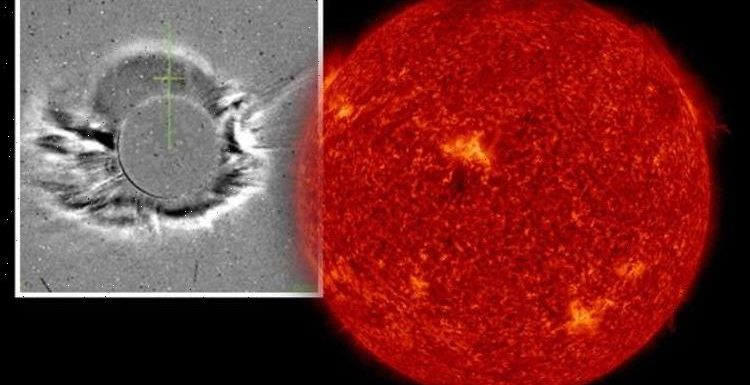
Earth’s ‘magnetic song’ captured during solar storm
We use your sign-up to provide content in ways you’ve consented to and to improve our understanding of you. This may include adverts from us and 3rd parties based on our understanding. You can unsubscribe at any time. More info
Space weather forecasters have adjusted their solar storm predictions after a coronal mass ejection (CME) detected on the weekend failed to materialise. Scientists warned the stream of charged particles and magnetic field from the Sun was due to hit on Monday evening, triggering the outbreak of a “moderate” solar storm. The US Space Weather Prediction Center (SWPC), which issued the original solar storm alert, has now said the space weather event will likely hit on Tuesday.
The SWPC said in its update: “The G2 (Moderate) geomagnetic storm watch continues for the remainder of October 11, 2021, and is now in effect for October 12, 2021.”
The CME was associated with an intense solar flare observed on the Sun early on Saturday.
According to the website SpaceWeather.com, the burst was a “halo” CME as it appeared to form a 360-degree disc around the Sun.
The CME was forecast to hit the planet head-on, leading to fears of imminent tech blackouts and power disruptions.


Solar storms, which are ranked on a scale of G1 (Minor) to G5 (Extreme), have the potential to disrupt satellite operations, mess with power grids and play havoc with communications.
In this case, the SWPC said the G2 storm could include power grid fluctuations, voltage alarms, increase drag on low-Earth satellites and mess with radio frequencies.
Of the less disruptive effects, the storm was expected to create beautiful auroras over parts of the UK.
However, these effects are now likely to be experienced on Tuesday.
The SWPC forecasters added: “Latest analysis and model guidance shows CME arrival likely late on October 11 into early October 12 UTC-days.”
Observatory captures INTENSE solar storm
This was confirmed by space weather physicist Tamitha Skov who has been following the CME since the weekend.
She tweeted on Monday: “Something definitely sideswiped us here, but I’m not convinced it is our halo #solarstorm.
“The speed of the #solar wind here is too slow for an eruption launched on October 9 to arrive now.
“Likely our #solarstorm is slower than anticipated and plans to be fashionably late.”
A second CME was observed on the Sun’s western edge on Sunday, however, this stream of particles is not expected to hit.


On Saturday she said the Sun has launched a “beauty of a solar storm” and that it was “headed straight for Earth”.
Original models predicted an impact around 5pm UK time or 12pm eastern time.
Dr Skov warned the storm could trigger disruptions to GPS signals and radio communications on the planet’s nightside.
British astronomer Tom Kerss meanwhile encouraged people to head outside for a glimpse of the resulting auroras.
Weather permitting, the Northern Lights or Aurora Borealis can be seen from the northernmost parts of Scotland.
In this case, however, the burst of solar activity was forecast to create auroras as far south as northern England.
Mr Kerss tweeted: “In the UK, this means widespread visible auroras for most of Scotland.
“Smaller surges may bring auroral light to northern horizon in northern England and NI (Omagh + farther north).
“Go out after sunset and stay out late! Stay warm.”
Source: Read Full Article